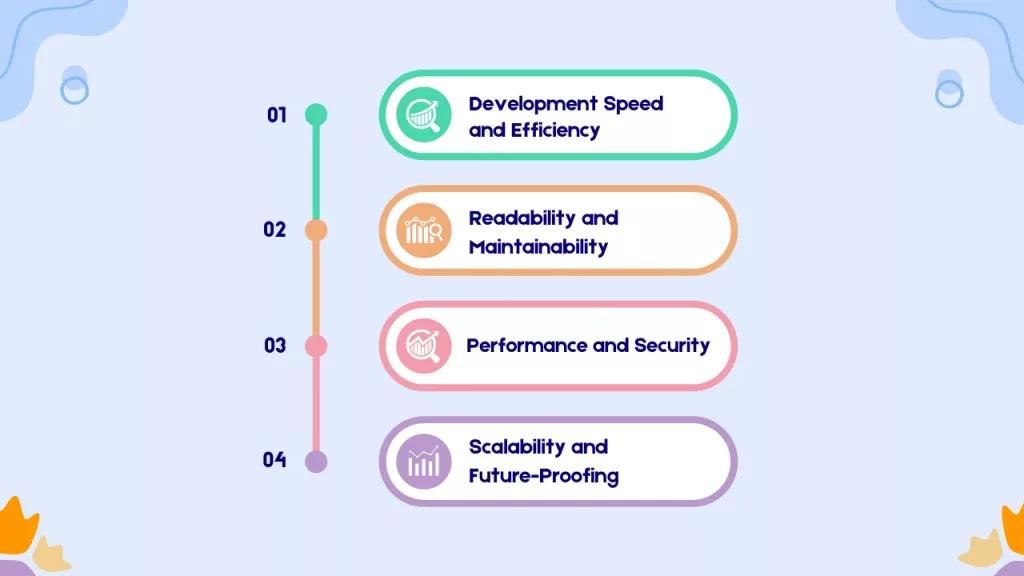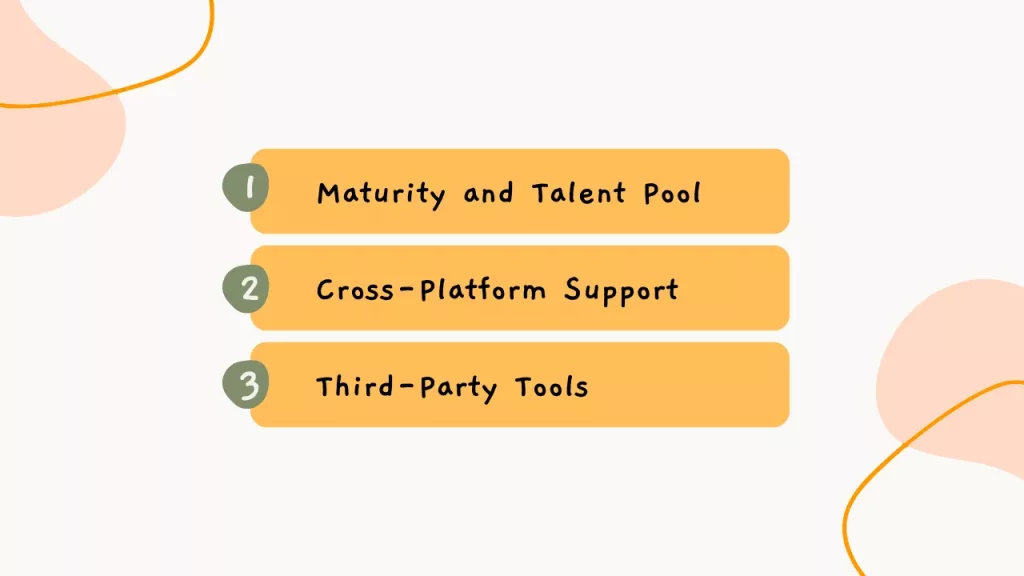Navigating the intricate world of app development demands careful consideration of the underlying technologies that power your vision. When targeting Apple devices, Swift has emerged as a compelling choice, capturing the attention of both established developers and ambitious newcomers. But before venturing down this path, it’s essential to comprehend Swift’s essence – its pros and cons of swift – to ensure a strategic decision aligns with your project’s goals.
What is Swift?
Think of Swift as a set of instructions, similar to a recipe, used to build applications for iPhones, iPads, Macs, and other Apple devices. It’s a modern, powerful and one of best programming languages designed to be easy to learn and use, even for those without extensive coding experience.
Unlike older languages, Swift emphasizes clean and concise code, which can lead to faster development times and fewer bugs. Additionally, it boasts automatic memory management, similar to a self-cleaning kitchen, simplifying a complex task for developers and potentially reducing app development costs and saving resources.
Why Consider Swift?
Several key features make Swift an attractive option. Its clean syntax and smart memory management enable developers to code faster, potentially saving time and resources – critical aspects for any business venture.
Swift’s modern design translates to optimized code and built-in security features, resulting in smooth and reliable applications for your users. The language’s active development, strong community support, and commitment to backward compatibility ensure your app can adapt and evolve alongside future technologies.
Pros of Swift Programming Language:

When building an app, time is money. Swift understands this, offering a unique blend of features that can translate to faster development cycles and streamlined maintenance, potentially saving you valuable resources. Let’s dive into the key advantages that make Swift an attractive choice for business owners, startups, and individuals alike.
1. Development Speed and Efficiency
When it comes to building an app, time is often money. Swift’s design prioritizes efficiency, which can translate to cost savings and faster time-to-market for your project. Here’s how:
A. Clean Syntax:
Imagine building a house with clear instructions and pre-cut materials. Swift’s concise syntax is similar, reducing code complexity and allowing developers to write more lines of code per hour compared to languages like Objective-C. This means less time spent struggling with code and more time focused on adding valuable features to your app.
B. Automatic Memory Management (ARC):
Think of memory management as cleaning your kitchen – essential, but time-consuming. With Swift’s ARC, the language handles memory allocation and deallocation automatically, similar to a self-cleaning kitchen! This frees developers from manual tasks, letting them focus on core development and potentially reducing the likelihood of memory-related bugs.
C. Faster Learning and Prototyping:
Just like building a Lego model helps visualize a final structure, tools like Swift Playgrounds and SwiftUI enable rapid prototyping and learning. Playgrounds is an interactive Swift learning environment, while SwiftUI simplifies user interface creation. These tools can significantly accelerate development cycles and allow you to develop your MVP app quicker.
Real-World Examples:
The proof is in the pudding. Studies have shown that apps built with Swift can be developed 20-50% faster compared to those using Objective-C. Companies like Lyft and Pinterest have successfully utilized Swift to streamline their development processes and deliver high-quality apps to their users quickly.
2. Readability and Maintainability
Building an app is just the beginning. As your app evolves and features expand, maintaining a clean and understandable codebase becomes crucial. Here’s how Swift shines in this aspect:
A. Clear Communication:
Imagine writing instructions for someone else to follow. Swift’s design emphasizes expressive code, meaning it reads more like natural language than a cryptic puzzle. This makes it easier for both the original developer and future contributors to understand the code’s purpose and logic, simplifying future updates and maintenance.
B. Error Prevention:
Think of typos in a recipe – they can lead to unexpected results! Swift’s design actively discourages common coding errors through features like type safety and optional values. This reduces the risk of bugs and unexpected behavior, saving time and resources during maintenance.
C. Long-Term Investment:
Consider a well-organized library. Easy navigation makes finding information efficient. Similarly, Swift’s well-defined structure promotes organized codebases, making it easier for new developers to join the project and contribute effectively. This ensures your app’s long-term maintainability and adaptability to future needs.
Studies show that code written in Swift has lower app maintenance costs compared to other languages. This translates to potentially significant cost savings and faster bug fixes over the lifetime of your app. Remember, a well-maintained app is a reliable and scalable app, ultimately benefiting both your business and your users.
3. Performance and Security
Just like a well-tuned engine delivers smooth performance, Swift’s modern design translates to faster, more responsive apps for your users. This can have a direct impact on user satisfaction and engagement, ultimately benefitting your business.
A. Optimized Code:
Imagine a well-tuned engine – efficient and powerful. Swift’s design prioritizes code optimization, similar to streamlining a car for better performance. This translates to faster execution times and smoother user experiences, crucial for keeping users engaged with your app.
B. Built-in Security
Think of your app as a fortress. Swift incorporates robust security features and ensures best security practices from the ground up, similar to building a house with strong locks and alarm systems. This helps protect your app and user data from potential vulnerabilities, giving you peace of mind and enhancing user trust.
C. Memory Safety
Imagine a car with automatic brakes – preventing accidents. Swift utilizes memory safety mechanisms, similar to brakes in a car, preventing memory-related crashes and bugs. This reduces the risk of app crashes and ensures a more stable and reliable user experience.
4. Scalability and Future-Proofing
As your app grows and your user base expands, your development needs will evolve. Swift’s design and active community ensure your app can adapt and scale alongside your business, providing a solid foundation for future growth. Here’s why:
A. Modular Design
Think of building blocks – flexible and adaptable. Swift’s modular design allows developers to easily add new features and functionalities to your app, similar to adding new blocks to a structure. This makes it easier to scale your app’s functionality as your needs evolve.
B. Active Community and Support
Imagine having a team of experts readily available. The Swift community is vibrant and collaborative, offering extensive resources, tutorials, and libraries. This means developers have access to support and best practices to help them navigate complex challenges and build scalable applications.
C. Continuous Evolution and Backward Compatibility
Think of a software update that doesn’t break your existing system. Swift’s design prioritizes backward compatibility, ensuring that your app remains functional even as the language evolves and new features are introduced. This helps protect your investment and simplifies future updates.
D. Potential for Cross-Platform Development
While currently focused on Apple platforms, Swift’s design and ongoing development hold promise for future cross-platform capabilities. This could potentially expand your app’s reach to a wider audience in the future, depending on your target market and goals.
Cons of Swift Programming Language

While Swift boasts attractive features, it’s crucial to acknowledge its potential drawbacks before making a decision. Here’s a balanced look at some challenges you might encounter:
1. Maturity and Talent Pool
Being a relatively young language, Swift might have a smaller pool of experienced developers compared to longer-established options. This could potentially impact project timelines and costs, especially for highly complex apps.
Strategies for Bridging the Gap:
- Consider upskilling your existing developers or leveraging online resources like Apple’s Swift Playgrounds and online tutorials to build your internal expertise.
- Look for development agencies or freelance developers with proven Swift experience to bridge the talent gap.
- Consider international markets with a growing Swift developer base.
2. Cross-Platform Support and Legacy Concerns
While Swift shines in building apps for Apple devices, its cross-platform capabilities are still evolving, presenting potential hurdles for businesses aiming for wider reach. Here’s a breakdown of the current landscape:
- Currently, Swift primarily targets Apple’s iOS, iPadOS, macOS, watchOS, and tvOS platforms. This might not be ideal if you envision your app reaching users on Android, Windows, or other operating systems.
- Swift’s constant evolution can sometimes lead to compatibility challenges with older iOS versions. This could impact users with older devices, potentially limiting your app’s reach.
- If you already have an existing app built with older languages like Objective-C, migrating to Swift might involve additional effort and potential compatibility issues.
3. Third-Party Tools and IDE Integration
Swift boasts a robust ecosystem, its integration with certain third-party tools and IDEs might not be as extensive compared to more established languages like Java or Python. This could potentially limit your development options or require additional effort.
Understanding the Landscape:
- While Swift integrates seamlessly with Apple’s Xcode, its integration with other popular IDEs like Visual Studio Code or IntelliJ IDEA might be less mature, requiring additional plugins or workarounds.
- Some specialized third-party libraries or tools might not yet have official Swift versions, potentially hindering specific functionalities or integrations.
Making the Decision: Swift vs. Alternatives
Deciding on the right programming language for your project is a crucial step. Swift boasts several advantages, it’s essential to consider your specific project requirements and weigh it against potential alternatives. Here’s a framework to guide your decision:
Key Factors to Consider:
1. Target Platform
Is your app primarily for Apple devices (iOS, macOS, watchOS, etc.)? If so, Swift shines with its native performance and deep integration with Apple’s ecosystem.
2. Cross-Platform Needs
Do you need your app to be available on other platforms (Android, Windows)? If so, consider established languages like Java or C++ or explore cross-platform frameworks like React Native or Flutter.
3. Performance and Security
Does your app require high performance and robust security? Swift’s modern design and built-in features excel in these areas.
4. Code Maintainability
Do you value clean and maintainable code for long-term development and updates? Swift’s readability and community support can be highly beneficial.
5. Existing Skillset
Does your development team have experience with Swift or similar languages? Leveraging existing expertise can save time and resources.
6. Learning Curve
Are you willing to invest in training your team or hiring developers with Swift experience? Consider the resources available and the potential learning curve involved.
When to Use Swift for Development:
1. iOS and macOS Development
If your app primarily targets Apple devices, Swift is an excellent choice. Its design and features are tailor-made for building high-performance, secure, and user-friendly apps for these platforms.
2. Server-Side Projects
For projects prioritizing speed, security, and scalability, such as backend APIs or microservices.
3. Modern and Maintainable Code
Building code with long-term sustainability in mind, reducing future maintenance costs and simplifying collaboration.
When to Use Alternatives:
1. Large Cross-Platform Projects
If your app needs to reach users across various platforms (Android, Windows, etc.), established languages like Java or Kotlin might offer wider cross-platform development compatibility through cross-platform frameworks like React Native or Flutter.
2. Projects Requiring Extensive Third-Party Libraries
Some specialized functionalities or tools might have more mature libraries and integrations with older, more established languages.
3. Tight Integration with Existing Codebases
Migrating existing code written in other languages to Swift might be challenging, and alternative languages might offer smoother integration.
Pros And Cons of Swift: Conclusion
Swift shines for native iOS and macOS development, prioritizing performance, security, and modern code. However, cross-platform needs, extensive library requirements, or tight integration with existing codebases might point towards alternative languages or frameworks.
Remember, the “best” option depends on your unique project and team. By carefully assessing your requirements, evaluating team expertise, and considering these key points, you can make an informed decision about whether Swift is the ideal tool to publish your app and propel your vision forward.

